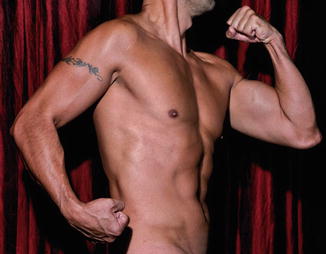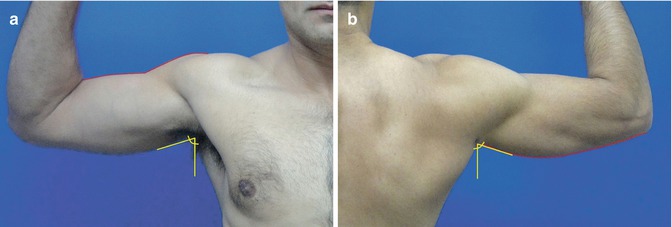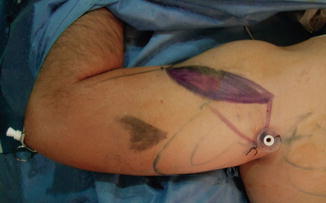and Peter M. Prendergast2
(1)
Elysium Aesthetics, Bogota, Colombia
(2)
Venus Medical, Dublin, Ireland
Introduction
No other anatomical region portrays physical strength, power, and masculinity in men than does the arm and shoulder. Ancient Greek and Roman sculptors and artists were aware of this and magnificently displayed these features in their works. In particular, Greek sculptors gloriously showcased the muscularity of the upper arm and deltoids in their sculptures. Their aim was to show the aesthetic ideals in healthy, athletic males, particularly in characters from Greek mythology, warriors, and ancient rulers.
The superficial fat structure, bilateral symmetry, and the skin thickness in this region make the task of contouring the arm one of the most challenging [1–3]. A thorough understanding of the local distribution of fatty tissue and muscular anatomy is essential for successful high-definition sculpting of the arms [4, 5]. The arm is divided into four regions: anterior, external, posterior, and internal. On the anterior, external, and internal regions, the fat is mainly of the superficial (areolar) type. This is usually a thin layer. For contouring, the most important region is the posterior aspect of the arm, where there is also a distinctive deep (lamellar) layer [5]. This layer varies in thickness, depending on the body mass index of the patient. This layer is mainly concentrated in the posterior external and anterior external regions, in the proximal and middle third of the arm. Liposuction in this area can be extensive and this can lead to skin laxity if optimal postoperative skin retraction is not achieved (Fig. 10.1).


Fig. 10.1
Anatomical basis of fat distribution in the arm according to Avelar [1]. Anterior (1), external (2), posterior (3), and internal (4) zones of the arm. Zone 3 is prone to store a larger amount of lamellar (deep) fat, which is the area of focused debulking during liposuction
The shape and contours of the arm are defined by the muscular disposition and mass [6–8]. In men, increased muscular mass correlates closely with an appearance of health and athleticism. The deltoid, triceps, and biceps muscles are mainly responsible for the shape of the arms and serve as guidelines for the surrounding structures (Fig. 10.2).


Fig. 10.2
Athletic male arms
The Arm Has Curves
An aesthetically pleasing well-formed arm has defining curves. The shape of the deltoid and biceps muscles defines the anterior arm. The posterior arm, however, is more difficult to define and model due to its unique fat distribution. On profile view with the arm in a 90° position, the athletic posterior arm has curves in the proximal and distal areas. In the ideal arm, the muscle mass of the triceps creates a convex area in the midportion, whereas the triceps tendon flattens the distal posterior arm.
The Youth Angle
The inferior border of the arm, with the shoulder in 90° abduction, defines an angle with a vertical parallel to the midline called the “youth angle.” The more acute the angle is, the more pronounced the triceps muscle mass. In obese and older patients, the angle tends to be obtuse due to the presence of extra fat and/or laxity of the skin (Fig. 10.3).


Fig. 10.3
A 42-year-old male. (a) The anterior portion of the arm is defined by the curvature of the deltoid and the biceps. Fat deposition in this portion is minimal even with moderate weight fluctuations and normal aging. (b) The posterior arm is prone to fat deposition due to the presence of deep (lamellar) fat and thin skin that increases in volume with weight changes (b). The posterior arm is not straight in its ideal aesthetic form; areas of curvature (negative spaces) are present in the proximal and distal arm due to the triceps tendon (distal) and the insertion of the proximal triceps. The angle between a vertical line and the proximal posterior arm is defined as the “youth angle” (yellow lines). This angle should be less than 90°
High-definition liposculpture helps attain an athletic appearance by shaping the body fat in multiple layers and over the entire arm contour by creating concave and convex zones [5]. This differs considerably from simply flattening the convex areas using conventional liposuction.
Stealth Incisions
The ideal incision points should be placed with the patient in the prone position, with 90° arm abduction, 90° elbow flexion, and complete external rotation. Usually three 5 mm incisions are made: in the posterior axillary crease, in the anterior axillary fold, and the last one at the elbow near the olecranon tip. Silicone ports and discs are placed into the incisions and sutured in place (Fig. 10.4).


Fig. 10.4
Incision sites with ports at the posterior axillary crease and the elbow
The Use of Drains
In general, drains are not required in this area. The incision near the elbow is left open to facilitate permissive drainage postoperatively. Prompt postoperative management, including massage, is important in order to achieve adequate drainage, reduce swelling, and accelerate healing.









